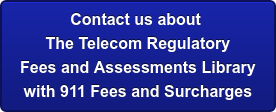 The Regulatory Mix, TMI’s daily blog of telecom related regulatory activities, is a snapshot of PUC, FCC, legislative, and occasionally court issues that our regulatory monitoring team uncovers each day. Depending on their significance, some items may be the subject of a TMI Briefing.
The Regulatory Mix, TMI’s daily blog of telecom related regulatory activities, is a snapshot of PUC, FCC, legislative, and occasionally court issues that our regulatory monitoring team uncovers each day. Depending on their significance, some items may be the subject of a TMI Briefing.
FCC Wireless Emergency Alert Rules
The FCC revised its Wireless Emergency Alert (WEA) rules to promote wider use and effectiveness of the service. Among other things, the FCC:
- increased the maximum Alert Message length from 90 to 360 characters for 4G-LTE and future networks;
- created a new Alert Message classification for, “Public Safety Messages” defined as “an essential public safety advisory that prescribes one or more actions likely to save lives and/or safeguard property;”
- required Participating Commercial Mobile Service (CMS) Providers to: (1) support embedded references (i.e., URLs and phone numbers) included in Alert Messages; (2) support transmission of Spanish-language Alert Messages; and (3) narrow their geographic targeting (geo-targeting) of Alert Messages to areas that best approximate alert areas specified by the alert originator; and
- required that WEA-capable mobile devices present Alert Messages as soon as they are received.
The FCC also required participating providers to log and maintain basic Alert Message attributes, and to make those logs available upon request to the FCC, FEMA, and emergency management agencies that offer certain confidentiality protections and made it easier for state and local authority to test WEAs, train personnel, and raise public awareness of the service. The FCC also seeks comment on additional improvements to the WEA system, including how to provide emergency managers with the ability to send multilingual alert content (in addition to Spanish) and measures to improve consumer education about WEAs.
FCC Mobile Broadband Deployment Data
The FCC’s Wireless Telecommunications Bureau released data on mobile broadband deployment as of December 31, 2015. These data were collected through FCC Form 477 and are available here. Coverage area maps (shapefiles) showing mobile broadband network deployment for each combination of provider and network technology are also available for download. Users can download a single, large zip file containing all provider coverage areas or a zip file for an individual provider. In addition, users can download tabular data showing mobile coverage in zipped CSV format by provider, state, or for the entire United States. For the first time, the CSV files present mobile coverage by technology at the census block level. Separate CSV files depict mobile coverage resulting from two different coverage analyses: centroid and actual area.
Separately, the Bureau released a Report describing and analyzing data on mobile broadband coverage based on Form 477 submissions, which will enable the FCC to make fact-based decisions regarding where and how high-cost support should be deployed through the Mobility Fund Phase II (MF-II). Staff focused its efforts on analyzing the Form 477 data to identify the areas within census blocks that do not today have unsubsidized 4G LTE coverage (i.e., 4G LTE coverage provided without any form of high-cost universal service support). Among other things, the results show that of the approximately 3.1 million people in areas with no LTE or only subsidized LTE; (1) 1.4 million have no LTE coverage; and (2) another 1.7 million live in areas where LTE coverage is provided only on a subsidized basis. The Report also shows that LTE coverage is provided only on a subsidized basis in a total area of 105,000 square miles, covering approximately 200,000 road miles, with the remaining uncovered area and road-miles falling in areas with no LTE coverage.
Iowa Complaint Rules
The Iowa Utilities Board has opened a rulemaking to consider changes to its Complaint Procedure rules. Most of the changes are not substantive. However, the Board is proposing to add language to Rule 6.4 to require staff to notify parties of their right to request formal proceedings; to clarify the requirements for a party to request that the record in a complaint be reopened; and for a notice to be issued by staff upon deciding to reopen the record. Comments may be filed by October 23, 2016 and replies by November 7, 2016.
TMI Regulatory Training | Technologies Management Inc.
TMI Fall 2016 October 18 - 19 in Maitland, FL - AGENDA
It is not too late to sign up. There are several seats available!




